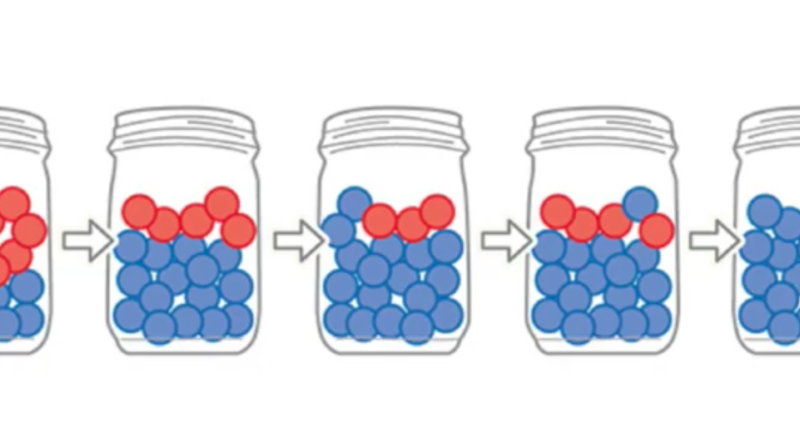This video discusses a fascinating study done by the Visual Communications Guy using the latest Pew Research Religious Landscape Survey. The study compares the largest 11 religions in the world in categories of happiness and religious devotion and finds some fascinating and surprising correlations. The best part of the study is the Latter-day Saints had the highest OVERALL score by a significant margin.
Okay, so on this video in the Evidences series, I wanted to talk about a fascinating article I saw the other day on the Religious Health-O-Meter. So this is something that was put together by The Visual Communication Guy. He’s got a great website. He does a lot of infographics and teaches communications, does a lot of corporate consulting. Anyway, he did this piece using the Pew Research study. The latest one, it’s the Pew Research Religious Landscape Survey. The last one that was done was in 2013. He used the data, collected some key metrics, and put together this Religious Health-O-Meter, he called it. It’s not scientific, but it was quite fascinating. The article that I saw that caught my attention said that the Latter-Day Saints won in a landslide on this study.
Anyway, so, looking at the detail, what he did, he wanted to compare and contrast religious devotion statistics with he called it the happiness factor. In fact, he said that there were a lot of surveys, “happiness surveys repeatedly repeat that the three main factors contribute to a happy life are financial stability, marriage, and a good education.” So those were the three he used for the happiness factors. And let me first tell you that there were 11 categories of religions. The four major world religions, Jews, Hindus, Muslims, and Buddhists. And then for the Christians, he actually broke into seven categories. He did Catholics, Evangelical Christians, Jehovah Witnesses, Historically Black Churches, Mainline Christians, Latter-Day Saints, and Orthodox Christians.
All 11 were then stack ranked from the Pew Research survey from 1 to 11. And that was your score for that category. So if you were at the top, you got 11 points. If you were at the bottom, you got 1 point. So that’s how it worked.
So if you first look at wealth, this was if you have income of over 50,000 per year. So take a look at the slide. If you look there, the number one there were the Jews. Number two were the Hindus. The bottom two, let’s see. Mainline Christians at 35% and then Historically Black Churches, 27%. Okay, to go to the next slide, education, at least some college. The top two is Hindus and Jews. The bottom two, Historically Black Churches and Jehovah’s Witnesses. Marital status. Number one, Hindu. 79%. And then Latter-Day Saints at 71%. The bottom there was Historically Black Churches at 33% and then Buddhists at 45%.
Now, the three categories for religious devotion. Number one, prayers claimed to be answered multiple times per month. Latter-Day Saints, number one. 54%. Closely followed by Historically Black Churches at 50%. Look at the Hindus at the bottom, 23%, and then the Jews at 12%. Then you go down to the next category under religious devotion was religious intensity. This is religion is important in one’s life. Number one at 98%, Historically Black Churches. Latter-Day Saints tied for second there at 96%. The bottom two it looks like were Buddhists and Jews. And then the last of the religious devotion, attend church at least weekly. Of the survey respondents, 85% for Jehovah Witnesses, number one. Latter-Day Saints were number two. The bottom two there, almost tied with each other, were Buddhists and Jews at 16 and 17%.
So, when you roll all this up, this is what the chart looks like for the overall Religious Health-O-Meter. You can see why they said the Latter-Day Saints won in a landslide. We were at 55 points on the overall score. Quite a bit of distance to number two which would have been it looks like the Hindus on there.
Then, if you actually look, it’s very fascinating what the facts suggest in the top right there. I’ll read this carefully. He says, “While no definitive conclusion can be made about a religious organization’s true well-being, it is interesting to note that there is a clear discrepancy between wealth and education, and religious devotion. Churches who scored high in wealth and education, Hindus and Jews for example, scored quite low in religious devotion. Conversely, churches who scored low in wealth and education, Historically Black Churches and Jehovah’s Witnesses, scored high in religious devotion. Most of the churches remain somewhere in the middle. Mormons are the anomaly in this chart as the only religious organization that scored high or relatively high in all six categories, making their comprehensive score, a 55, much higher than the others.”
So there’s not a whole lot you can put in the statistics on all this. I just thought it was a fun thing to share on one of the Evidences videos. Hope you enjoyed it. Subscribe for more.
Resources:
Original study:
https://thevisualcommunicationguy.com…
Latter-day Saints’ Q&A is a video series not produced by The Church of Jesus Christ of Latter-day Saints, but by me, an ordinary member of The Church of Jesus Christ of Latter-day Saints, an independent voice, with a passion for studying Church history and defending the faith. In this series, I provide evidences for the restoration, and address tough questions posed by critics of the Church of Jesus Christ of Latter-day Saints, offering faithful answers based on accurate research and historical references which will be posted at the end of each video.






